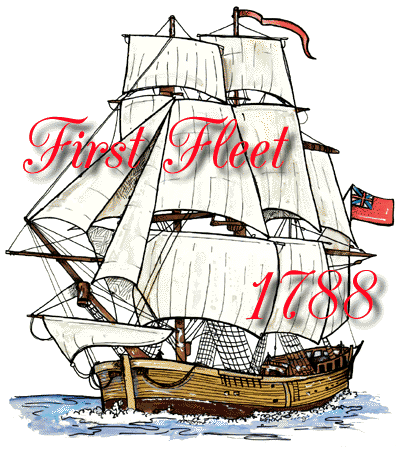
Australia's First Fleet was commissioned by Captain Arthur Phillip, R.N. who was commissioned as the first Governor of New South Wales.
He set sail on May 13th, 1787 from Portsmouth with 11 vessels. He arrived in New South Wales in 1788 with 717 convicts guarded by 191 marines under 19 officers. Their voyage lasted 251 days and as Britain could no longer send its convicts to Virginia or Georgia they sent them to Australia.
The first boat "Supply' sailed into Botany Bay on 18th January and the rest followed within the next two days. The fleet had travelled over 15,000 miles with only 40 dying.
Captain Phillip wasted no time in surveying Botany Bay and set of to Port Jackson on January 22nd 1788, named by James Cook in 1770, and choose an area as a suitable site for settlement. On January 26th 1788 the British flag was unfurled and flew on Australian soil for the first time. Australian's since this time have celebrated this day as "Australia Day".
Australian Government before 1901.Before the British settled in Australia in 1788 the Aborigines had lived in the country for at least 40,000 years. They lived in tribal groups who shared religious and food gathering righrs over their tribe's area of land. Everyone in the tribe shared the same language and customs. In these groups authority was usually held by religious leaders, elders and great fighters. Government was informal but effective in maintaining law and order.
Great Britian established the first European colony in Australia, at Sydney, NSW, on January 26th, 1788. Captain Arthur Phillip, the leader of the First Fleet, became the colony's Governor. David Collins was Judge Advocate and the laws he imposed on the settlement were those of Great Britian. The British Government appointed different Governors to rule New South Wales, as Australia was then called. The name Australia was suggested by explorer Matthew Flinders and was in use by the 1820s. This was from the Latin name for the continent, Tera Australis Incognita meaning the Unknown South Land. Seperate British colonies were set up in Tasmania (then known as Van Diemen's Land) in 1825, West Australia in 1829, South Australia in 1836, Victoria in 1851 and Queenslad in 1859. The Nothern Territory was established in 1963 as part of South Australia. Each colony was self-governing by 1890s, having its own government and laws.
1901 - FederationThe six Australia colonies become the Commonwealth of Australia
From the 1880s onwards the people of the seperate states of Australia began to see that a central, or Federal government ruling over all the states as one independent country would be benefical. Seperate development was causing many problems. There was little cooperation and much debat on issues such as the defence of Australia, Chinese immigrationm the kidnapping of Pacific Islanders to work on Queenslan famrs, and the railway deveolpment - New South Wales had built its railway system with a different guage to neighbouring states. In addition there were disagreements over import taxes.
In 1890 Sir Henry Parks. who is often called "the fatehre of Federation", presided over a conference in Melbourne. Here it was agreed that an Australian Federal Government with powers to make laws and carry them out should be established. The states would retian many powers but the Federal Government would have the power over defence, postal services, immigration and foreign affairs.
Agreement was hindered by the question of where the money would come from to finance a new Federal Government. In 1891, at a Federal convention in Sydney, the first draft of the Australian constitution was drawn up. Edmund Barton toured a campaign for Federation. In 1898 and 1899 the people voted to accept the redrafted consitution. With British approval the six colonies became a new nation, the Commonwealth of Australia, on January 1st 1901. The unification of the colonies became the states of Australia. The nation kept the British monarch as head of state but adopted its own flag. The first Parliament met in Melbourne until a site for the national capital could be selected and developed.
HOME
Click on the graphic to vote for this
page as a Starting Point Hot Site.

FastCounter by bCentral